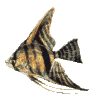|
SPAWNING THE BARBUS TETTEYA
(Cherry Barbs)
by Melanie Koehn
Barbus tetteya more commonly known as the Cherry Barb is found
in the streams and rivers on the plains of Sri Lanka.
Cherry Barbs have to be one of my most favorite of the Barbus
species. Its their color. The males are so bright red (Cherry) that
they are an absolute knock out. The females are not near as
bright, but are a lot fuller in the body.
Both sexes are of equal size, approximately 2 inches in length.
After owning a large school of Cherry Barbs for two years, I
thought I should try spawning them. This meant that in order to
start, I had to find out how they spawn. After asking a few people
how they had done it I chose the method that seemed easiest to
me. I set up a ten gallon aquarium, filled with water from the
mother aquarium, a submersible heater set for 78 degrees F, a
bubble filter, and lots and lots of Java Moss which basically filled
the aquarium top to bottom, and side to side. It was all placed on
the kitchen counter in indirect sunlight because I was told that
Cherry Barbs spawn first thing in the morning. Now it was time
to select the breeding stock. For better odds I decided to use a trio.
I selected the two fattest females and the most colorful male.
Within an hour the male was chasing the females all around. I
turned the lights out. The next morning I got up early to in hopes
of seeing them spawn, but with all the Java Moss I could hardly
see the fish much less any eggs. After the kitchen was fully lit I
looked again but could still see nothing, so I thawed out some
Formula II which is a frozen food made up primarily of vegetable
matter and krill. They came up to the surface to eat so I felt that
my mission to spawn them had failed.
I left the trio in the spawning aquarium for about a month. Doing
1/3 bi weekly water changes, and feeding them lots of brine
shrimp and Formula II. I kept looking daily to see if I could see
any fry. I had been told however that the fry are extremely tiny
and would look like slivers of glass, but I never saw a thing.
After 30 days I decided to attempt to try separating the 2 females
from the male for two weeks to try again.
I started to move the Java Moss to one side so I could place a
divider in the aquarium, and to my absolute surprise there were
fry!! Large ones, medium ones, small ones, and slivers of glass.
WOW!!
I removed the parents from the aquarium, and immediately began
to feed micro-worms and baby brine. I have since removed the
Java Moss so that it would be easier to keep the water clean.
There are approximately 30 fry now, and I am doing a 1/3 water
change every other day to ensure their health. The fry have grown
rapidly and are gaining their color nicely.
For those of you that would like to try this I would suggest that
you remove the parents right from the start to see if you may be
able to get more fry that I did. Good Luck!
(This material was obtained from CompuServe's FISHNET
computer information services)
Reprinted from The Kitsap Aquarian, the newsletter of the Kitsap
Aquarium Society. Articles and illustrations may be reprinted
with due credit given to the society and the author.
| 